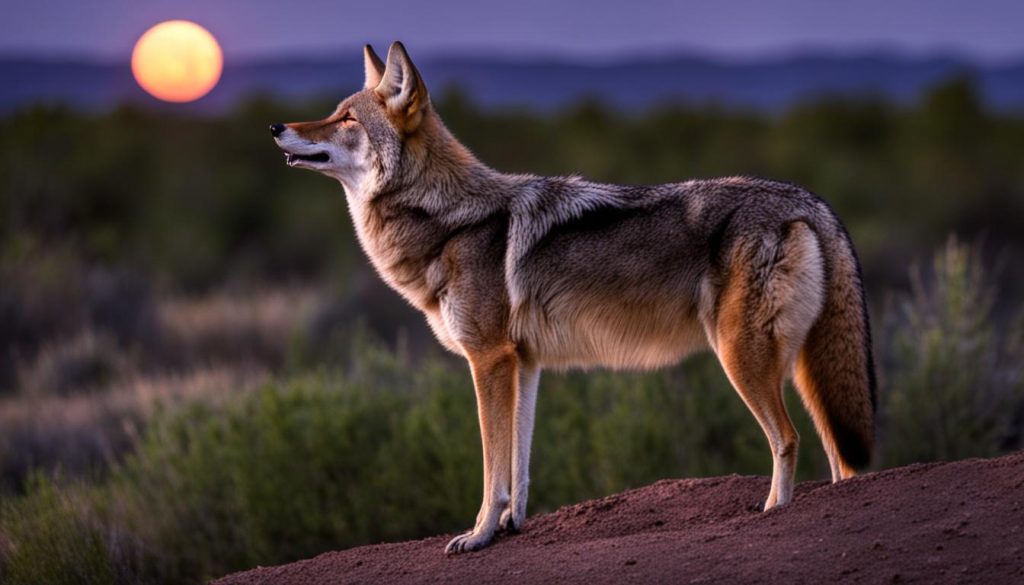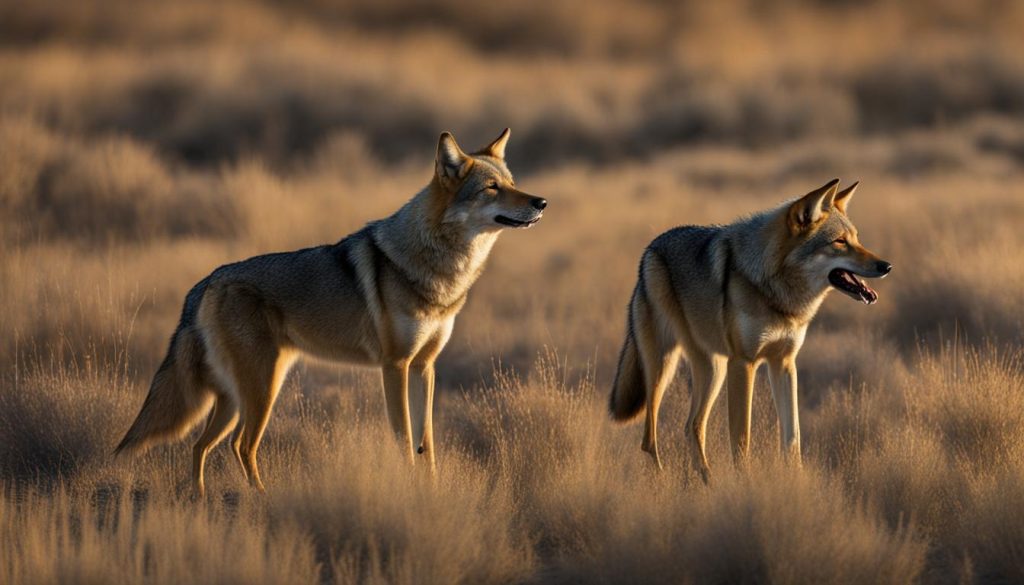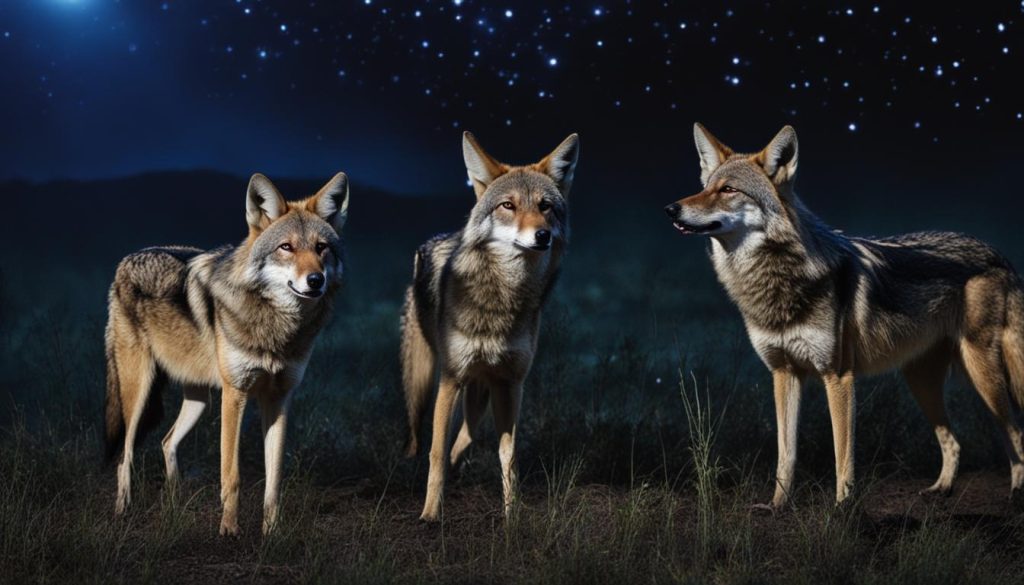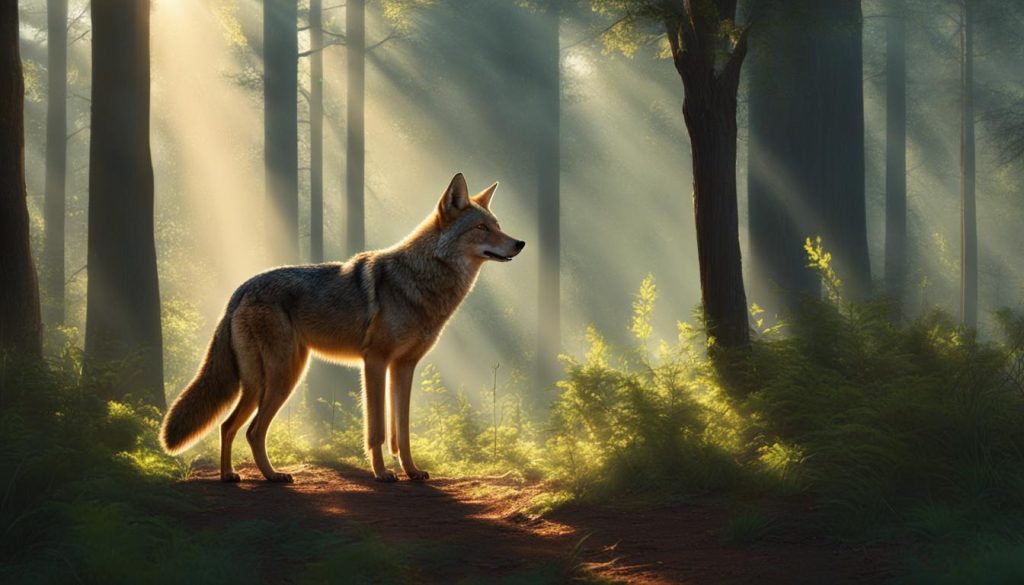I’m excited to delve into the fascinating world of coyote vocalizations. As a journalist, I often find myself captivated by the unique sounds and behaviors of wildlife. Today, we’ll be exploring the vocalizations of coyotes and how they differ from those of dogs. By understanding their communication patterns, we can gain valuable insights into coyote behavior and better appreciate their role in the natural world.
Key Takeaways:
- Coyotes have a wider range of vocalizations compared to dogs.
- Coyote vocalizations serve various purposes, including defending territory and attracting mates.
- Howling is a signature sound of coyotes and plays a significant role in their communication.
- Coyotes have the ability to sound larger than they are through vocal deception.
- By understanding and appreciating coyote vocalizations, we can foster peaceful coexistence between humans and coyotes.
The “Song Dog”: Coyote Vocalizations Compared to Dogs

When it comes to vocalizations, coyotes and dogs share some similarities, but coyotes have their own unique sound that sets them apart. While both can bark, howl, and yip, coyotes’ vocal range is broader and more varied. This has earned them the nickname “song dogs.”
To distinguish between coyote and dog barks, coyote barks tend to be higher-pitched and quicker. They often consist of multiple rapid barks, whereas dogs typically have lower-pitched and more sustained barks. By paying attention to these distinctions, we can identify the source of vocalizations and gain insights into the behavior of nearby animals.
Table: Comparing Coyote and Dog Vocalizations
| Characteristic | Coyote Vocalizations | Dog Vocalizations |
|---|---|---|
| Pitch | Higher-pitched | Lower-pitched |
| Duration | Quick, multiple barks | More sustained barks |
| Variety | Varied vocal range | Less varied |
By recognizing these vocal differences, we can better understand the behaviors and intentions of coyotes and dogs. This knowledge is essential for distinguishing between the two species and interpreting their communication.
Howling: A Signature Sound of Coyotes
Coyote howling is a distinctive vocalization that sets them apart from other animals. Unlike the long, drawn-out howls of wolves, coyote howls are characterized by high-pitched barks and yips. Howling serves various purposes for coyotes, including communication within their pack, marking territory, and warning off competitors or predators.
One fascinating aspect of coyote howling is its ability to create the impression of a larger pack size. When coyotes howl together, their voices synchronize and can give the impression that there are more individuals present. This vocal strategy can deter potential threats and competitors, as it creates the illusion of a formidable pack.
To enhance the effectiveness of their howls, coyotes also utilize wavering howls and rapid changes in pitch. By bouncing their howls off objects in the environment, such as rocks or trees, coyotes can amplify their vocalizations and make them carry over longer distances. This combination of vocal techniques makes coyote howls captivating and far-reaching.
Understanding the patterns and meanings behind coyote howls can provide valuable insights into their behavior and social dynamics. By listening to and observing these signature vocalizations, researchers and wildlife enthusiasts can gain a deeper appreciation for the language of coyotes and the role it plays in their survival and communication.
| Howling | Meaning |
|---|---|
| Multiple coyotes howling together | Signaling a presence of a pack, defending territory |
| Individual coyote howling | Locating family members, attracting mates |
| High-pitched barks and yips in a rapid sequence | Warning off competitors or predators |
Coyote Vocal Deception: Sounding Bigger Than They Are

When it comes to vocalizations, coyotes have a remarkable ability to sound larger than their actual size. This vocal deception is a strategic communication strategy used by coyotes to deter competitors or predators. By utilizing wavering howls and rapid changes in pitch, coyotes create the impression of a larger pack, instilling fear or caution in potential threats. Additionally, coyotes can bounce their howls off objects in their surroundings, such as rocks or trees, effectively amplifying the sound and further enhancing the illusion of a formidable group.
This vocal deception plays a crucial role in the social dynamics of coyotes. By sounding bigger than they actually are, coyotes can assert dominance, defend their territory, and protect their resources. It is a testament to their intelligence and adaptability as they use vocal communication to navigate their environment and ensure their survival.
“Coyotes have developed a unique ability to manipulate their vocalizations, creating the illusion of a larger pack size. This deceptive behavior is a powerful tool in their communication arsenal.”
Understanding coyote vocal deception provides valuable insights into their behavior and communication strategies. It allows us to appreciate the complexity of their social interactions and the lengths they go to protect their interests. By listening closely to their vocalizations and studying their tactics, we can gain a deeper understanding and respect for these fascinating creatures.
Developing Appreciation for Coyote Vocalizations

As I delved deeper into understanding coyote behavior and vocalizations, I developed a newfound appreciation for these fascinating creatures. Coyote vocalizations serve as a reflection of their social nature and their ability to adapt and survive in various environments.
By listening and interpreting their vocalizations, we can gain valuable insights into their communication patterns and behaviors. It is truly remarkable to witness how coyotes utilize an intricate language-rich communication system to defend their territory, locate family members, and attract mates.
Appreciating coyote vocalizations goes beyond mere admiration for their unique sounds. It fosters a greater respect for these intelligent and adaptable animals and the important role they play in ecosystems. By embracing their vocal expressions, we can forge a deeper connection with nature and promote peaceful coexistence between humans and coyotes.
As I reflect on my journey of understanding and appreciating coyote vocalizations, I am reminded of the beauty and complexity of the natural world. The melodic and distinct sounds of coyote howls can be likened to a form of natural music, captivating our senses and evoking a sense of wonder.
It is my hope that more people will take the time to appreciate and listen to coyote vocalizations, recognizing the depth of their communication and the significance of their presence in our environment. Let us embrace the opportunity to learn from and coexist harmoniously with these remarkable creatures.
Understanding the Differences: Coyotes vs. Dogs

When it comes to vocalizations, coyotes and dogs may share some similarities, but there are significant differences that can help us distinguish between the two. Let’s explore the physical description, temperament, and vocal behaviors that set coyotes apart from dogs.
Coyote Physical Description
Visually, coyotes have smaller and thinner frames compared to most dogs. They typically stand 20 to 24 inches tall at the shoulder and weigh between 20 to 50 pounds. Coyotes have distinct features, such as a pointed snout, tall ears, and a bushy tail that is usually carried low. In contrast, domestic dogs come in various sizes, but they tend to have a more muscular build, shorter snouts, and tails that may be curled or carried high.
Coyote Temperament
Coyotes are generally more solitary animals compared to dogs, which are highly social and have been domesticated by humans for thousands of years. Coyotes are known to be highly adaptable and have developed a cautious and wary temperament due to their need to survive in a wide range of environments. This temperament influences their vocal behaviors, as coyotes primarily use their vocalizations for defense, communication within their pack, locating family members, and attracting mates.
Distinguishing Coyotes from Dogs
One of the key ways to distinguish between coyotes and dogs is by their vocalizations. While dogs primarily bark to communicate socially and express emotions, coyotes have a wider range of vocalizations that serve specific purposes. Coyote vocalizations may include high-pitched barks, howls, yips, and even growls. These vocalizations are used to defend territory, locate family members, and attract mates. By recognizing these vocal differences and considering the physical description and temperament, we can accurately identify whether we are hearing a coyote or a dog in our surroundings.
| Aspect | Coyotes | Dogs |
|---|---|---|
| Physical Description | Smaller and thinner frames, pointed snout, tall ears, low-carried bushy tail | Varies in size, more muscular build, shorter snout, curled or high-carried tail |
| Temperament | Solitary, cautious, wary | Social, domesticated, friendly |
| Vocalizations | High-pitched barks, howls, yips, growls | Barks to communicate socially and express emotions |
Instinct, Breeding, and Adaptation: Factors Influencing Vocal Differences

Understanding the vocal differences between coyotes and dogs can be attributed to various factors, including instinct, breeding, and adaptation. Coyotes possess a more territorial nature, leading to louder and more aggressive barks and howls. This instinctual behavior is driven by their need to defend their territory and ward off potential threats.
In terms of breeding, coyotes have been bred and adapted to survive in various environments, which has contributed to their more vocal nature compared to dogs. They have developed complex vocalizations to communicate with their pack members, locate family members, and attract mates. These adaptations have allowed coyotes to thrive in diverse habitats, from forests to deserts.
Furthermore, the heightened awareness and alertness of coyotes also contribute to their intense vocalizations. As highly adaptable animals, coyotes are constantly attuned to their surroundings and use their vocalizations as a means of navigation and communication. Their ability to sound larger than they actually are through vocal deception is a testament to their resourcefulness.
Table: A Comparison of Coyote and Dog Vocal Behaviors
| Factor | Coyotes | Dogs |
|---|---|---|
| Instinct | More territorial, leading to louder and more aggressive vocalizations | Primarily bark to communicate socially and express emotions |
| Breeding | Developed complex vocalizations for communication within their pack, family members, and mates | Less varied vocal range compared to coyotes |
| Adaptation | Highly adaptable and vocal to survive in diverse environments | Less vocal and more dependent on visual cues |
By considering these factors, we can gain a deeper understanding of the vocal behaviors of coyotes and dogs. It is fascinating to observe how these animals have evolved to use vocalizations as a means of communication and survival. Appreciating the complexity of their vocal expressions allows us to develop a greater respect for wildlife and the natural world.
Enjoying the Beauty of Coyote Vocalizations

Listening to the melodic and distinct sounds of coyote howls can be a truly mesmerizing experience. It allows us to connect with the natural world and appreciate the beauty of wildlife vocalizations. The haunting refrain of a group of coyotes howling in unison can evoke a sense of wonder and awe, reminding us of the untamed wilderness.
Appreciating coyote vocals is not only about the auditory pleasure they bring, but also about gaining a deeper understanding of nature. By taking the time to listen to these vocalizations, we can learn about the unique communication methods of these intelligent and adaptable animals. It is through their howls, barks, and yips that coyotes convey messages to their pack members, defend their territory, and attract mates.
Furthermore, appreciating coyote vocals can foster a sense of respect for wildlife and the delicate balance of ecosystems. It reminds us of the intricate web of life and the important role that each species plays in maintaining biodiversity. Instead of fearing or viewing coyote vocalizations as a nuisance, we can embrace them as a part of the natural symphony around us.
So, take a moment to step outside, breathe in the crisp air, and listen to the enchanting chorus of coyote howls. Let their harmonies transport you to the wild places that still exist and allow yourself to appreciate the wonders of nature.
Wrapping Up
Understanding coyote vocalizations is crucial for comprehending their communication patterns and behavior. These vocalizations are a complex and rich form of expression that serves various purposes within the social dynamics of coyotes. By delving into the unique world of coyote vocalizations, we can gain a deeper appreciation for these intelligent and adaptable animals.
Appreciating wildlife vocalizations, including those of coyotes, allows us to connect with nature on a profound level. The melodic and distinct sounds of coyote howls offer a window into the wilderness, inviting us to listen and marvel at the beauty of natural music. Rather than fearing these vocalizations, taking the time to understand and appreciate them enhances our enjoyment and understanding of the natural world.
Through recognizing the differences between coyote and dog vocalizations and considering the factors that influence vocal behavior, we develop a greater respect for wildlife. Coyote vocalizations highlight the importance of preserving and respecting the habitats of these animals, as they play a vital role in maintaining the delicate balance of our ecosystems. Let us continue to explore the enchanting world of coyote vocalizations and appreciate the wonders of wildlife communication.
FAQ
Do coyotes bark like dogs?
While both coyotes and dogs can bark, coyotes have a wider range of vocalizations that include higher-pitched and more varied barks.
What are the unique vocalizations of coyotes?
Coyotes have a distinctive sound that sets them apart from dogs. Their vocalizations include high-pitched barks, yips, and howls.
What are coyote vocalizations used for?
Coyote vocalizations serve various purposes, including defending territory, locating family members, and attracting mates.
How can I distinguish coyote barks from dog barks?
Coyote barks tend to be higher-pitched, more varied, and consist of multiple quick barks, while dog barks are generally lower-pitched and more sustained.
What is the purpose of coyote howling?
Coyote howling serves various purposes, including communication within their pack, marking territory, and warning off competitors or predators.
How do coyotes create the impression of a larger pack through vocal deception?
Coyotes can create the impression of a larger pack by utilizing wavering howls, rapid changes in pitch, and bouncing their howls off objects in the environment to amplify their vocalizations.
What are the differences between coyotes and dogs in terms of vocalizations?
Coyotes have a wider range of vocalizations and are more territorial and alert, while dogs primarily bark to communicate socially and express emotions.
What factors influence the vocal differences between coyotes and dogs?
The vocal differences between coyotes and dogs can be attributed to instinct, breeding, and adaptation to their environments.
How can I appreciate the beauty of coyote vocalizations?
Taking the time to listen and appreciate coyote vocalizations can enhance our understanding and enjoyment of nature.
What can understanding coyote vocalizations teach us about their behavior?
Understanding coyote vocalizations can provide insight into their behavior, social dynamics, and their role in ecosystems.






